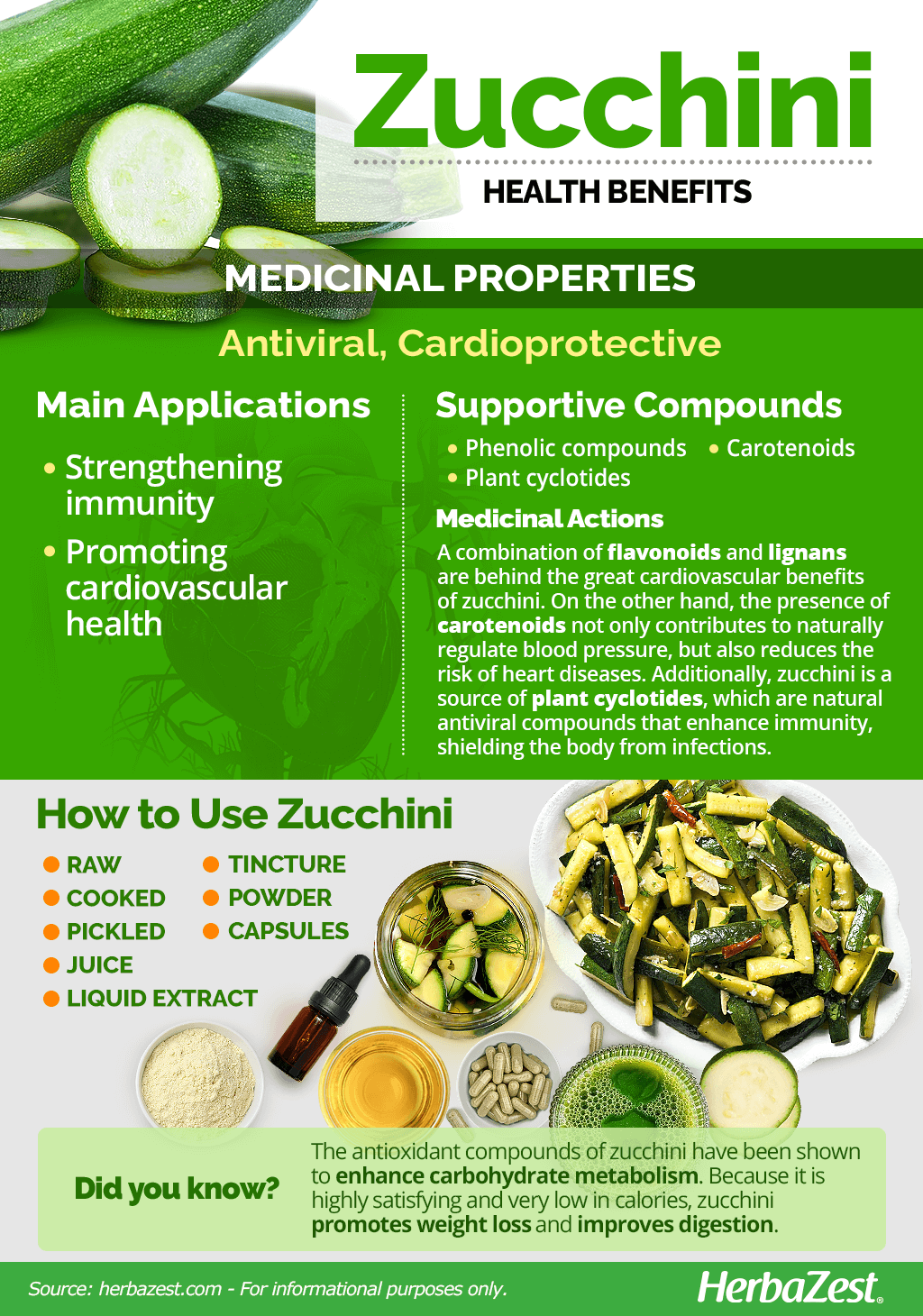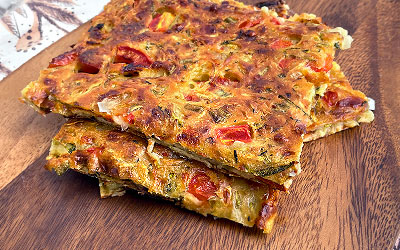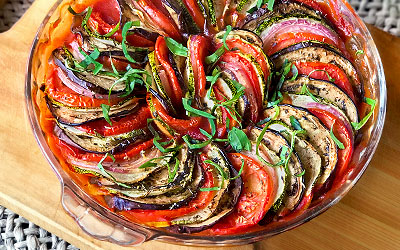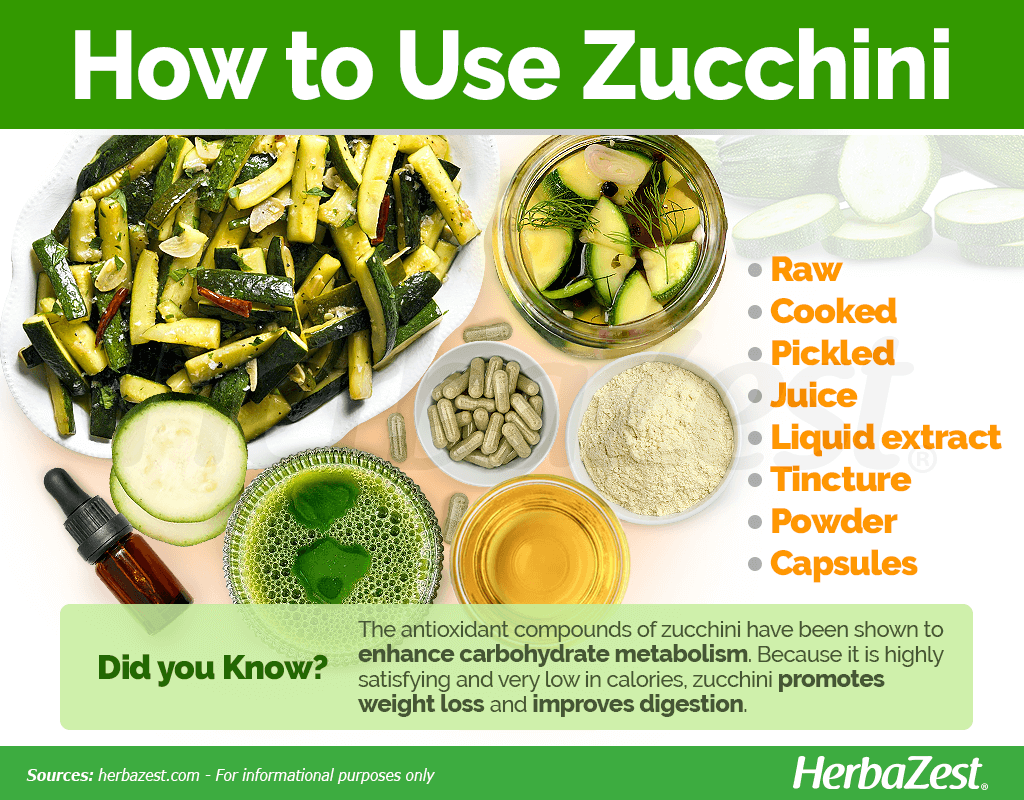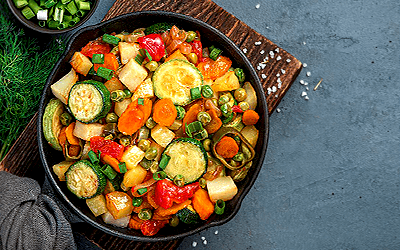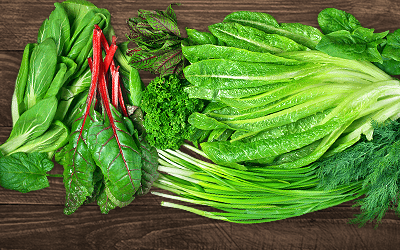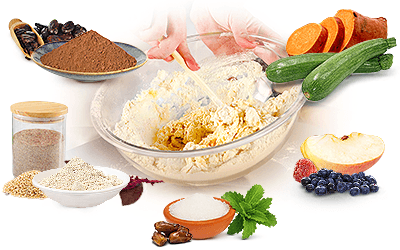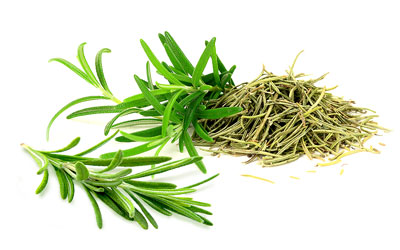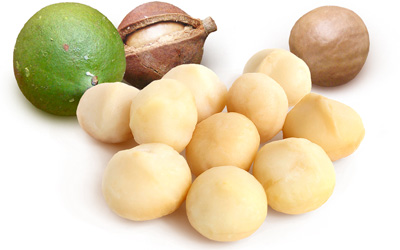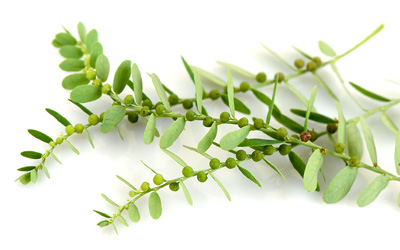A beloved member of the Cucurbitaceae family, zucchini, also known as Italian zucchini and courgette, has found a myriad of culinary uses, due to its edible skin and mildly-flavored, fleshy interior. Scientific studies have revealed the great nutritional and medicinal value of this summer squash. ¡Keep reading to discover all the health benefits of zucchini!
Zucchini Medicinal Properties
Widely preferred for its thin, edible skin, the zucchini has become a food staple around the world. In spite of little research done on this popular type of summer squash, it is known that zucchini benefits are similar to those of its relatives in the pumpkin family:
Strengthening immunity. The antiviral compounds of zucchini enhance immune function, protecting the human body from dangerous diseases.
Promoting cardiovascular health. The antioxidant properties of zucchini improve and protect hearth function and blood vessels, not only contributing to stabilize blood pressure, but also preventing diseases related to oxidative stress.
Because it is highly satisfying and very low in calories, zucchini can also aid weight loss and improve digestion.
The antioxidant compounds of zucchini have been shown to activate the immune response and enhance carbohydrate metabolism.1
How It Works
The most important active substances responsible for the benefits of zucchini are phenolic compounds.2
A combination of flavonoids and lignans are behind the great cardiovascular benefits of zucchini.3 On the other hand, the presence of carotenoids not only contributes to naturally regulate blood pressure, but also reduce the risk of heart diseases.
Additionally, zucchini is a source of plant cyclotides, which are natural antiviral compounds that enhance immunity, shielding the body from infections.4
Other herbs with similar cardiovascular benefits are kaniwa, pumpkin, sacha inchi, sweet potato, and tomato. Additionally, antiviral cyclotides have been found in staple foods like potato and cucumber.
Side Effects of zucchini
Zucchini is considered generally safe to consume in dietary amounts, with no reported side effects or interactions. However, this fruit-vegetable may cause allergic reactions in sensitive individuals, including nausea, diarrhea, and itchiness.5
- Medicinal action Antiviral, Cardioprotective
- Key constituents Phenolic compounds, carotenoids, plant cyclotides
- Ways to use Capsules, Hot infusions/tisanes, Liquid extracts, Food, Juiced, Tincture, Powder
- Medicinal rating (2) Minorly useful plant
- Safety ranking Safe
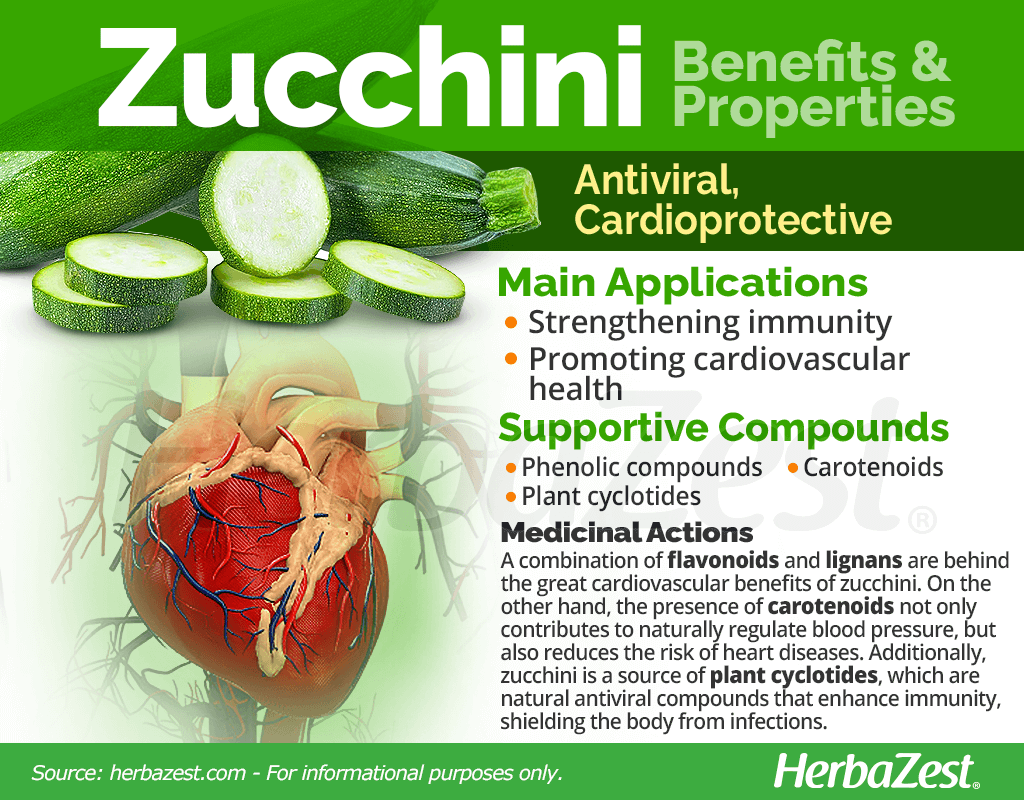
Zucchini Nutrition
The nutritional value of zucchini hails from its good amounts of essential vitamins and minerals. Being low in calories and rich in water content, zucchini is an ideal food for weight management.
Zucchini's key minerals include potassium, essential for electrolyte balance, muscle contraction and nerves; copper, necessary for red blood cells production and transport; and manganese, instrumental for the formation of bones, connective tissue, adequate blood clotting, and sex hormones production. Additionally, zucchini provides small amounts of iron, magnesium, phosphorus, and zinc, all of which contribute to overall health.
In the vitamin's department, zucchini brings important nutrients to the table, mainly B2 (rivoflavin), which is crucial for energy production processes, including carbohydrates metabolism and optimal cellular function. Additionally, B2 plays an important role in maintaining stable levels of homocysteine, an amino acid that participates in cellular metabolism as well as in the synthesis of proteins. Folate is also present in good amounts in zucchini; this vitamin is instrumental for fetal development as well as for brain function. Zucchini nutritional value is rounded by small amounts of vitamin C (ascorbic acid).
100 grams of raw zucchini, with skin, have 94.8 grams of water and provide only 17 calories, along with 2%DV of protein, 1%DV of carbohydrates, and 4%DV of dietary fiber.
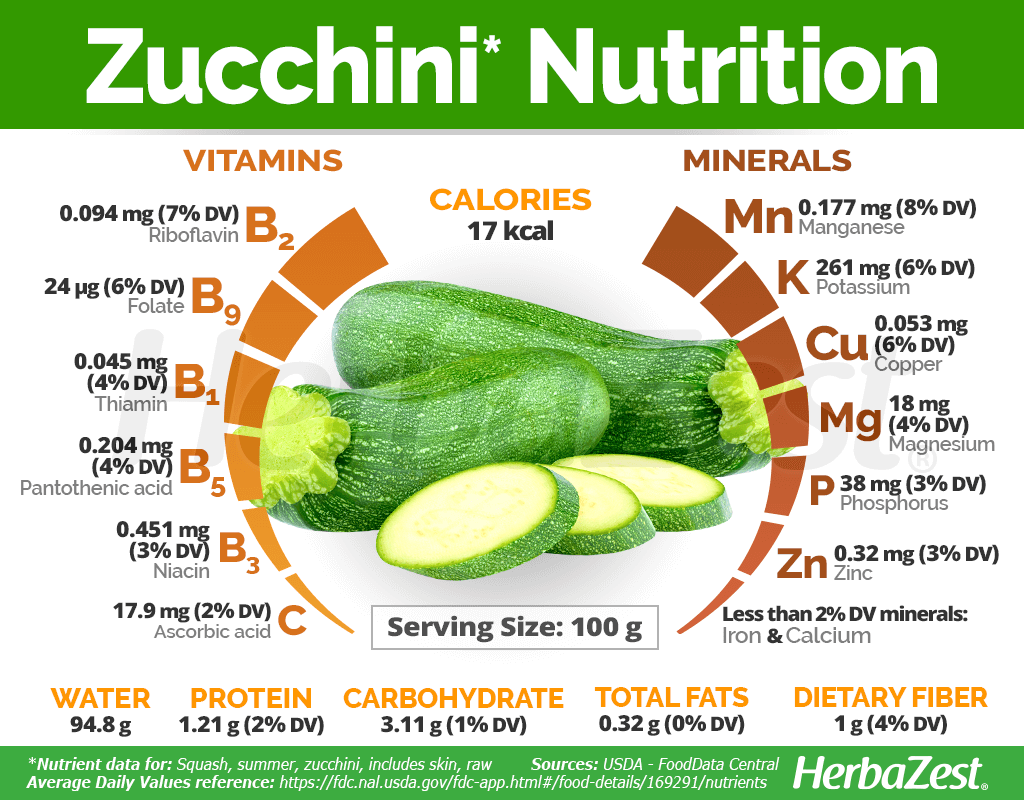
How to Consume Zucchini
The most popular uses of zucchini are culinary. The versatility of this seasonal fruit-vegetable makes it ideal for soups, stews, and baked goods. However, for specific health purposes, zucchini can also be found in natural remedies and supplements that concentrate its antioxidant compounds.
The zucchini flower is also edible, and often consumed stuffed and used to garnish culinary preparations.
Natural Forms
Raw. Zucchini's soft skin and crispy flesh can be enjoyed raw in salads and appetizers.
Cooked. Zucchini can be enjoyed in a myriad of recipes, steamed, grilled, roasted, in soups and stews.
Pickled. Small varieties of zucchinni can be preserved and stored to consume at any time of the year.
Juice. The nutritional content of zucchini can also be obtained by extracting its fresh juice, since this is a vegetable with plenty of water.
Herbal Remedies & Supplements
Liquid extract. Obtained from zucchini seeds, this preparation is rich in essential nutrients, like vitamin A, that promote a healthy, youthful skin.
Tincture. In this form, which needs to be diluted in water, zucchini compounds are thought to help prevent urinary tract infections as well as supporting eye health.
Powder. Both green and yellow zucchini can be dehydrated and make into a fine powder, which can be added to virtually anything, from salads to shakes.
Capsules. Zucchini powder can also be consumed as a dietary supplement, in capsules, in order to reap its antioxidant and cardioprotective benefits.
- Edible parts Fruit, Leaves
- Taste Mild
Growing
The zucchini plant is a type of summer squash that thrives in warm climates around the world. This annual crop is very satisfying to cultivate in a back yard due to its easy care and minimal requirements. ¡Following these guidelines will ensure a successful harvest every year!
Growing Guidelines
The zucchini plant requires plenty of sun exposure and a warm weather to grow. It is sensitive to cold temperatures and frost will surely kill it.
Like other summer squashes, zucchini plants are propagated through seeds, which can be planted in pots and kept indoors about three weeks in advance to be transplanted after the last frost, when the soil is warmer.
Zucchini seedlings or seeds need to be planted 24 inches (61 cm) apart on 36 to 48 inches (91-122 cm) wide beds.
The best soil for a zucchini plant is fertile, well-drained, and rich in organic matter.
Zucchini thrives on a pH between 6.0 to 7.5, but it tolerates soils with a pH of up to 8.0. Fertilization will depend on soil conditions and a test before planting is recommended.
The zucchini plant is a vine, and can grow upwards if given a trellis to climb.
Zucchini plants are susceptible to insects, such as leaf miners, aphids, cutworms, squash vine borers, squash bugs, cucumber beetles, mole crickets, and fruit worms. They also can be affected by diseases like downy mildew, powdery mildew, mosaic viruses, fruit rots, and root-knot nematodes.
- Life cycle Annual
- Harvested parts Flowers, Fruit
- Light requirements Full sun
- Soil Medium (loam), Well-drained
- Soil pH 6.1 – 6.5 (Slightly acidic), 6.6 – 7.3 (Neutral)
- Growing habitat Warm climates
Additional Information
Plant Biology
Among summer squashes, zucchini, also known as courgette, is easily recognized by its cylindrical shape, and its edible skin that can be smooth and shinny, or slightly ridged. Zucchini flowers are yellow and their size depends on the sex. Male flowers are thin and small, while female flowers have thicker stems with a compact bulge at the base, from which the fruit will develop. Fruit colors can range from white-green, light green, medium green, and dark green to bright golden-yellow. In most varieties of zucchini, the average diameter of the fruit is of 3 to 4 inches (7.6 - 10.6 cm); however, it is not uncommon to see sizes up to 20 inches (50 cm) in length, depending on how long they are left to grow. This annual vine have trailing stems from which large, heart-shaped leaves grow; they are characterized by light greenish gray splotches and streaks on the surface, which may be mistaken for a mildew problem.
Classification
The zucchini plant is one of several varieties of summer squash (Cucurbita pepo), and belongs to the large Cucurbitaceae family, which comprises about 990 species, including pumpkin, cucumber and melon. The genus Cucurbita encompasses over 27 species, including a variety of squashes, gourds, and pumpkins.
Varieties of zucchini
Zucchini is actually a variety of summer squash; however, many different cultivars have been created through the years. The most popular types of zucchini are the most colorful, such as the green and yellow ones, but there are many others in between, more or less available depending on the region, with similar flavor and nutritional content.
Historical Information
All members of Cucurbitaceae family are native to the Americas, from Central United States to Argentina, and were introduced to Europe during the 16th century. However, zucchini originated in Naples, dating back to 1811, as part of the Cocozelle Group, characterized by cylindrical fruits with thin, edible skin.
The word zucchini is though to have its roots in Tuscany, and originally referred to dry, small bottle gourds used as storage for tobacco. It wasn't until 1840's that the meaning of this Tuscan word changed to name the elongate fruits of C. pepo.
Economic Data
As a summer squash, zucchini, also known as Italian zucchini, green zucchini, and yellow zucchini, is nowadays cultivated across warm regions of the world. The main producer of zucchini is China, followed by other large producers, including India, Ukraine, Russia, and Mexico. The annual global trade of zucchini amounted over 17 million tons in 2018.6
Other Uses
Cosmetic industry. Zucchini essential oils are used to produce skin care products and fragrances.
Fodder. The excess of zucchini production is commonly used to feed farm animals.
- Other uses Animal feed
Sources
- Antioxidants (Basel), The Profile of Selected Antioxidants in Two Courgette Varieties from Organic and Conventional Production, 2020
- FoodData Central, Squash, summer, Zucchini, includes skin, raw, 2019
- Foods, Bioactive (Poly)phenols, Volatile Compounds from Vegetables, Medicinal and Aromatic Plants, 2021
- Fruits and Veggies, Zucchini
- Molecules, Naturally Lignan-Rich Foods: A Dietary Tool for Health Promotion?, 2019 | Comparative Phytochemical, Antioxidant and Haemostatic Studies of Preparations from Selected Vegetables from Cucurbitaceae Family. 2020
- Nutrients, Role of Zucchini and Its Distinctive Components in the Modulation of Degenerative Processes: Genotoxicity, Anti-Genotoxicity, Cytotoxicity and Apoptotic Effects, 2017
- Oregon State University, College of Agricultural Sciences. Department of Horticulture. Oregon Vegetable Squash, Zucchini and Summer
- Plant Physiology, Expression of Ascorbic Acid Oxidase in Zucchini Squash (Cucurbita pepo L.), 1991
- Scientific Reports, Preparations from selected cucurbit vegetables as antiplatelet agents, 2021
- The Zucchini Squash, 2019
- University of Florida, IFAS Extension - Squash, Zucchini - Cucurbita pepo L.
- University of Maryland, Growing Summer Squash (Zucchini) in a Home Garden
- University of Minnesota, Extension - Real Life, Good Food, Zucchini
Footnotes:
- Voprosy Pitaniia. (2016). The study of physiological effect of fruit and vegetable powders in animal experiment. Retrieved February 12, 2024, from: https://pubmed.ncbi.nlm.nih.gov/29376308/
- Molecules. (2020). Comparative Phytochemical, Antioxidant and Haemostatic Studies of Preparations from Selected Vegetables from Cucurbitaceae Family. Retrieved February 12, 2024, from: https://www.ncbi.nlm.nih.gov/pmc/articles/PMC7570563/
- Journal of Cardiovascular and Thoracic Research. (2018). Association of modified Nordic diet with cardiovascular risk factors among type 2 diabetes patients: a cross-sectional study. Retrieved February 12, 2024, from: https://www.ncbi.nlm.nih.gov/pmc/articles/PMC6203863/
- Journal of Allegy and Immunology. (2000). Allergy caused by ingestion of zucchini (Cucurbita pepo): characterization of allergens and cross-reactivity to pollen and other foods. Retrieved February 12, 2024, from: https://pubmed.ncbi.nlm.nih.gov/10932084/
- Nutrients. (2020). Antiviral Functional Foods and Exercise Lifestyle Prevention of Coronavirus. Retrieved February 12, 2024, from: https://www.ncbi.nlm.nih.gov/pmc/articles/PMC7551447/
- Horticultura Brasileira. (2021). Production cycle and characterization of Italian zucchini genotypes by the logistic model. Retrieved March 6, 2024, from: https://www.scielo.br/j/hb/a/7x838Q4LsJkkgRTW7Ch7MvH/?lang=en
